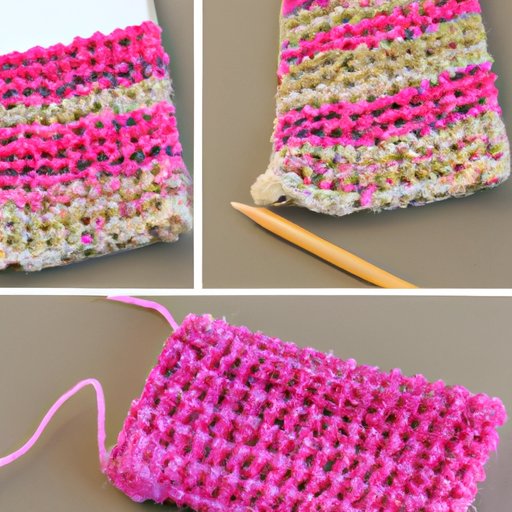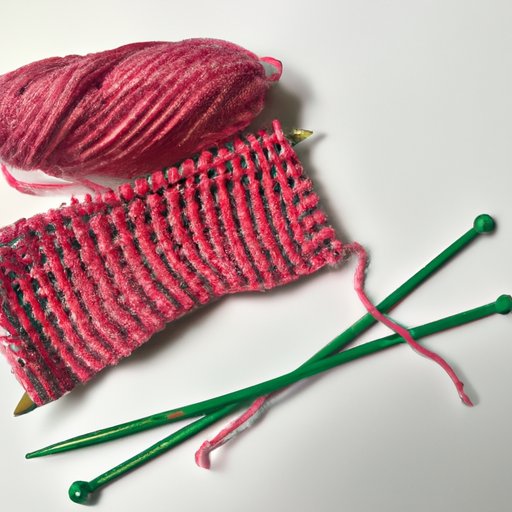
Introduction
Knitting is a therapeutic and fulfilling hobby that allows you to create beautiful and functional pieces of clothing and home decor. One of the essential techniques every knitter must master is M1 knitting. M1 knitting is a method that increases the number of stitches on your needle by creating a new stitch out of a strand of yarn. In this article, we will explore M1 knitting in-depth and provide you with a step-by-step guide, tips and tricks, advanced techniques, mistakes to avoid, and recommended patterns to practice the M1 knitting technique.
Mastering the M1 Knitting Technique: Steps to Follow
M1 knitting is a simple technique that requires only a few steps. Here is our step-by-step guide on how to M1 in knitting:
1. Knit up to the stitch where you want to make the increase.
2. Insert the left needle into the strand of yarn between the stitch you just worked (the old stitch) and the next stitch on the left.
3. Lift this strand onto the left needle, creating a new stitch.
4. Knit the new stitch through the back loop to prevent a hole from forming.
M1 Knitting for Beginners: Tips and Tricks
For most beginners, the most difficult step in M1 knitting is knowing where to insert the needle to create the new stitch. Here are some tips and tricks to help you understand the M1 knitting technique better:
– Pay close attention to the placement of the new stitch. If it’s too far away from the old stitch, there will be a hole in your knitting. If it’s too close, there will be an increase in the number of stitches you’re working with.
– Use a stitch marker to remind you where you need to insert the left needle to create the new stitch.
– Practicing on swatches can be helpful to get a feel for the technique before using it on a full pattern.

The Different M1 Knitting Techniques and How to Choose the Right One
There are several different techniques to create an M1 stitch, each with its own unique qualities. Here are some of the most popular M1 knitting techniques and how to select the right one for your project:
– M1L (Make 1 Left): This technique creates a new stitch that slants to the left, making it ideal for shaping on the left side of your knitting.
– M1R (Make 1 Right): This technique creates a new stitch that slants to the right, making it ideal for shaping on the right side of your knitting.
– KFB (Knit Front and Back): This technique not only creates a new stitch but also increases the number of stitches on your needle.
The technique you choose will depend on the type of project you are creating and the effect you want to achieve.
Advanced M1 Knitting Techniques: Level Up Your Knitting
If you are an experienced knitter looking to improve your M1 knitting skills, here are some advanced tips and techniques to help you achieve a more perfect stitch:
– Experiment with different yarn weights to achieve different effects.
– Practice creating an M1 stitch using different stitch patterns, such as ribbing or cables.
– Create M1 increases in the middle of a row by using techniques such as a double increase or a triple increase.
Mistakes to Avoid While M1 Knitting
Mistakes can be frustrating, especially when you’ve put a lot of effort into your knitting. Here are a few common mistakes that can occur while M1 knitting and some tips on how to avoid them:
– Creating a hole: Ensure that you knit the new stitch through the back loop to avoid creating a hole.
– Creating too many stitches: Pay attention to the placement of the new stitch to avoid creating extra stitches.
– Pulling the stitch too tight: Be gentle when pulling the stitch tight to prevent it from distorting the rest of the row.
5 Patterns to Practice M1 Knitting
Now that you’ve got the hang of the M1 knitting technique, it’s time to put your skills into practice. Here are five patterns perfect for practicing your M1 knitting:
1. Knitted Crescent Shawl: This simple pattern uses M1 increases to create a beautiful and practical shawl.
2. Baby Blanket: This easy pattern will give you plenty of practice with M1 knitting while creating a lovely blanket for a little one.
3. Fingerless Gloves: Create a stylish and cozy pair of fingerless gloves while improving your M1 knitting skills.
4. Cabled Hat: This pattern will provide plenty of opportunities to practice M1 increases while creating a cozy and fashionable hat.
5. Cardigan: Take your M1 knitting to the next level with this intermediate pattern that uses M1R and M1L increases to create a stunning cardigan.
Conclusion
Congratulations, you’ve mastered the M1 knitting technique! We’ve covered everything from the basics to advanced tips and tricks, common mistakes to avoid, and patterns to put your skills to use. Remember to continue practicing and experimenting with different techniques to improve your knitting skills.




